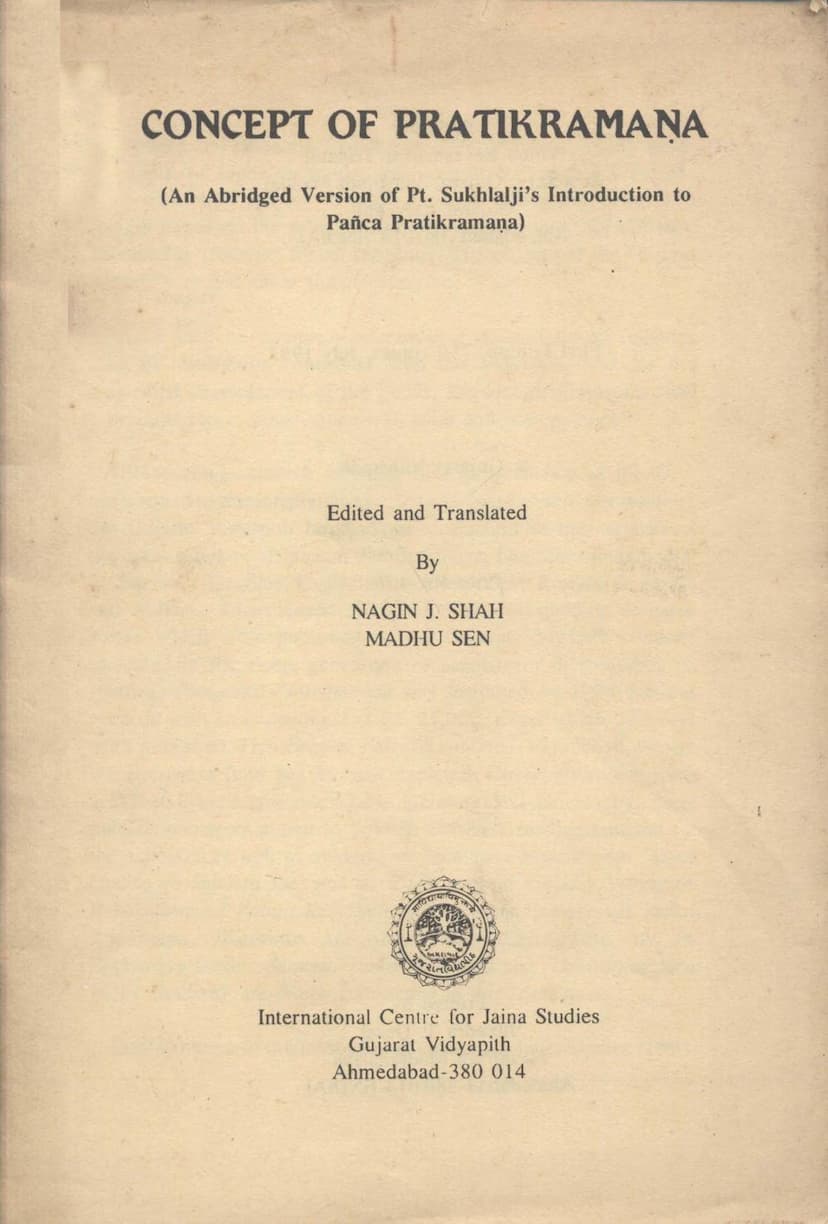Concept Of Pratikramana
Added to library: September 1, 2025

Summary
Here's a comprehensive summary of the provided Jain text, "Concept of Pratikramana," based on the information presented across the pages:
Overall Purpose and Context:
The book "Concept of Pratikramana" is an abridged English version of Pt. Sukhlalji Sanghavi's introduction to his work "Pañca Pratikramaņa." Published by Gujarat Vidyapith in 1993, it aims to make this important Jain concept accessible to a wider audience, including scholars and general readers. The Gujarat Vidyapith, founded by Mahatma Gandhi, emphasizes education based on non-violence and respect for all religions, making the study of Jainism a significant part of its mission. The book is a product of the newly established International Centre for Jaina Studies, signifying a commitment to promoting and disseminating Jain knowledge.
Core Concept of Pratikramana:
- Definition: Pratikramana, fundamentally, is the process of returning the soul to its original pure nature. The soul, by its inherent essence, is pure but becomes impure through contact with adventitious impurities, primarily attachment (rāga) and aversion (dvesha). Pratikramana involves removing these impurities to restore the soul to its pristine state.
- Relationship to Samayika: Pratikramana is considered the prime means to achieve sāmāyika, a state of equanimity where one treats all living beings as oneself, free from attachment and aversion. Sāmāyika is the first and most important of the six essential daily acts (āvaśyakas) in Jainism.
- Process: Pratikramana involves refraining from sinful acts and seeking forgiveness for those committed in the past. This is achieved through kāyotsarga (renouncing attachment to the body and realizing the soul as distinct) and pratyākhyāna (firm determination not to commit sinful acts in the future and repentance for past ones).
- Goal: The ultimate goal of pratikramana is to free the soul from lethargy (pramāda), develop spiritual vigilance, eliminate impurities and defects, and ultimately become vītarāga (one completely free from attachment), leading to liberation.
The Six Essential Acts (Āvaśyakas):
The book extensively details the six essential acts that are central to Jain spiritual practice. These are:
- Sāmāyika: Cultivating equanimity and treating all beings equally. It's divided into partial (for laypeople) and complete (for monks).
- Caturvimśatistava: Devotional praise of the 24 Tirthankaras, involving both external (ritual) and internal (mental) forms of praise.
- Vandana: Offering respectful salutations to spiritual teachers and venerable monks (ācāryas, upādhyāyas, etc.).
- Pratikramana: The act of repentance, confession of past sins, and resolving to avoid future transgressions.
- Kāyotsarga: Renouncing attachment to the body and concentrating the mind for meditation.
- Pratyākhyāna: Renunciation and declaration of abstaining from specific actions or impure states, leading to the stoppage of karmic influx.
Order and Spirituality of the Āvaśyakas:
The book emphasizes the logical and spiritual progression of these six acts. Sāmāyika is the foundation for true praise (Caturvimśatistava). Praising the Tirthankaras cultivates respect for their teachings, leading to Vandana (salutations to teachers). Confession of faults (Pratikramana) is best made to a respected teacher. Purifying the mind through confession enables effective meditation (Kāyotsarga), which in turn strengthens the will for renunciation (Pratyākhyāna). This interconnectedness highlights the profound spirituality of these acts, aiming for the soul's gradual purification and ultimate liberation.
Historical and Comparative Aspects:
- Origin: The six essential acts, particularly the Āvaśyakasūtra, are believed to have been conceived by elders (sthaviras) after the direct disciples (ganadharas) of Lord Mahavira, not by Mahavira himself or his immediate disciples. The Āvaśyakasūtra is placed in the period between the 5th century BC and the first quarter of the 4th century BC.
- Comparison with Other Religions: The book draws parallels between Jain "essential acts" and practices in other religions like Vedic rituals, Zoroastrianism, Christianity, and Islam, highlighting the universality of spiritual discipline and the pursuit of inner purity across different faiths. Examples include the Gayatri hymn in Vedic tradition and the "Saranaṁ gacchāmi" in Buddhism compared to Jain Namaskāra Mantra and refuge-taking.
- Evolution of Sutras: The text discusses the gradual incorporation of various sūtras into the Pratikramana ritual, acknowledging that while the core remains, additions and variations have occurred over time due to temporal and regional factors.
- Sectarian Differences (Śvetāmbara and Digambara): The book notes that both major Jain sects value the āvaśyakas. While the Svetāmbara tradition has preserved the Āvaśyakasūtra more comprehensively, Digambara texts like Mūlācāra also describe these acts, showing similarities in core verses despite some differences in the order of practices.
Conventional Meaning of Pratikramana:
Initially, "pratikramana" referred specifically to the fourth essential act. However, over time, it has become a common term for all six essential acts (ṣaḍāvaśyaka) due to its significant role in spiritual purification.
Attacks and Refutations:
The book addresses criticisms leveled against the āvaśyaka acts:
- Duration: Critics deem the acts too long. The refutation is that this is due to laziness and a lack of duty.
- Meaningless Recitation: Some argue that reciting without understanding is like a parrot. The response is that faith is crucial, and one should seek knowledge from the learned.
- Language: Objections are raised about the ancient Prakrit/Sanskrit used. The defense is that these languages preserve the sanctity, charm, and power of the mantras, and translation can diminish their essence. The unity experienced through reciting original texts is also highlighted.
- Dislike: The sentiment of dislike is attributed to the mind, not the external texts. Acquiring knowledge of their goodness fosters liking.
Selected Pratikramaņa Sūtras (Appendix):
The appendix provides the text and translations of key sūtras used in Pratikramana, including:
- Namaskāra-sūtra (Navakāra Mantra)
- Iriyāvahī-sūtra (regarding harm during walking)
- Tassa uttarīkaraṇa-sūtra (for spiritual elevation and purification)
- Annattha-sūtra (related to Kāyotsarga and its limitations)
- Logassa-sūtra (praise of the Tirthankaras)
- Karemi bhamte sūtra (Sāmāyika)
- Khamāsamaṇa sūtra (salutation to teacher)
- Jam Kimci sūtra (pilgrimage salutation)
- Arihanta ceiāņam (meditation on temples)
- Kṣamāpanā sūtra (request for forgiveness)
In essence, "Concept of Pratikramana" serves as an accessible guide to a fundamental Jain practice, explaining its meaning, significance, historical context, and comparative relevance, ultimately aiming to inspire spiritual growth and understanding.